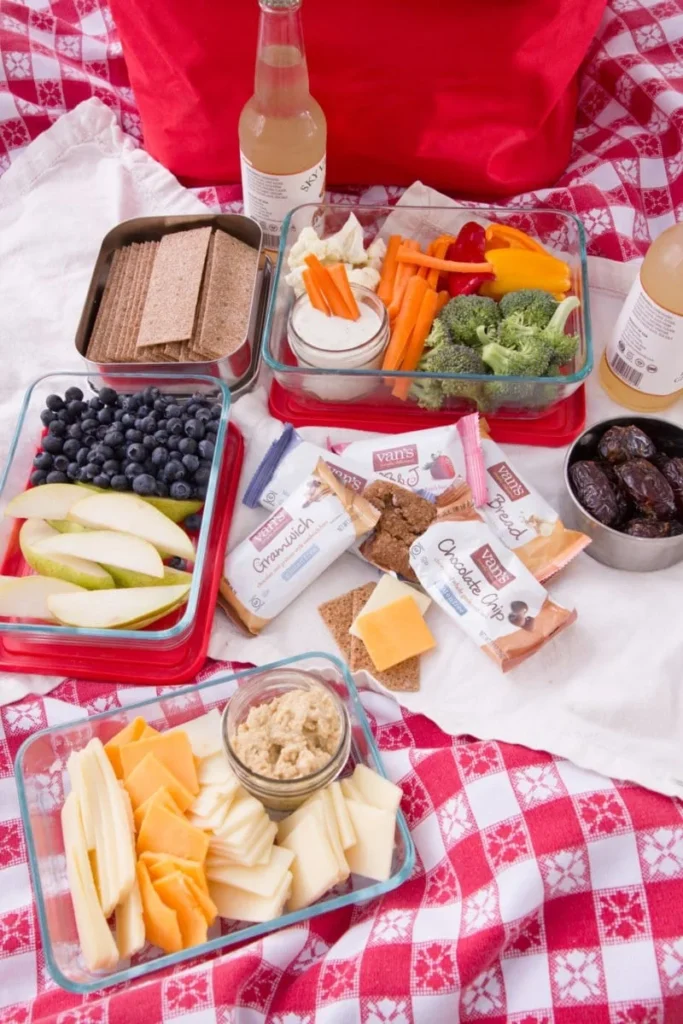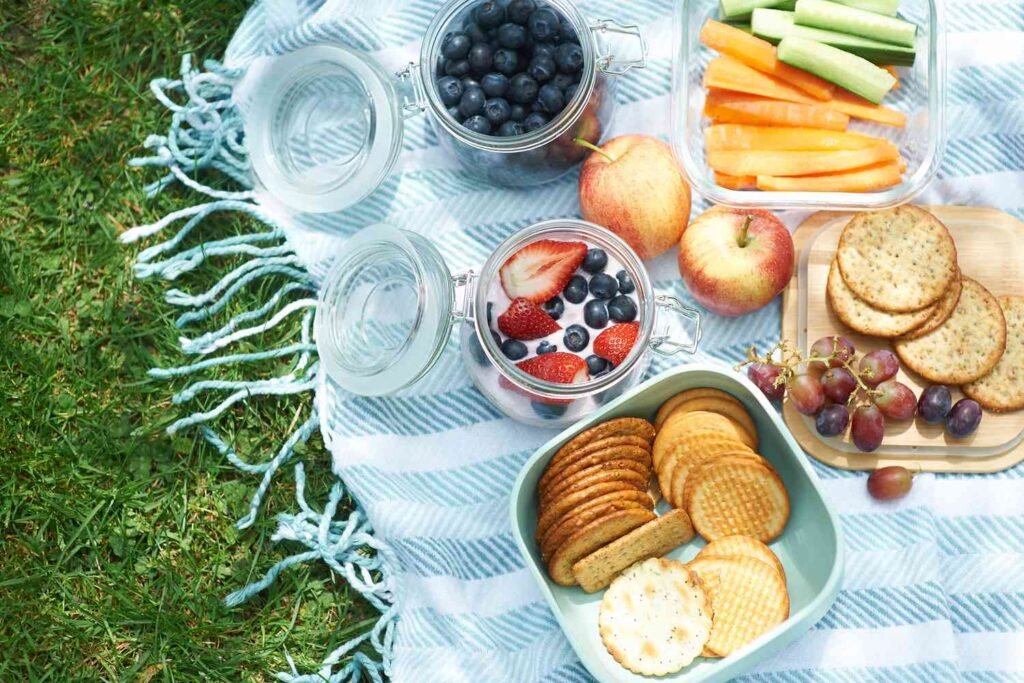Picnics are a timeless way to enjoy nature, socialize with family and friends, and savor wholesome, fresh foods. Unlike formal meals, picnics offer freedom, creativity, and a relaxed environment that fosters connection and mindfulness. Planning a picnic may seem simple, but thoughtful preparation ensures that food is fresh, transportable, and enjoyable, while creating an overall memorable experience. This article explores the benefits of picnicking, strategies for planning, plant-based food ideas, and practical tips to make every outdoor meal both nutritious and delightful.
The Benefits of Picnics

1. Connection with Nature
Eating outdoors provides a unique opportunity to connect with the natural environment. Fresh air, sunlight, and greenery have been shown to reduce stress, improve mood, and enhance overall well-being. Picnics combine the sensory pleasures of food with the restorative effects of nature.
2. Social Bonding
Picnics are ideal for building relationships. Sharing meals encourages conversation, laughter, and teamwork when preparing food together. Whether it’s a family outing, a gathering of friends, or a romantic meal, picnics create lasting memories and strengthen social connections.
3. Promotes Healthy Eating
Picnics are an excellent opportunity to focus on whole, plant-based foods. Fresh fruits, vegetables, grains, and legumes provide essential nutrients, while avoiding overly processed and fast foods often consumed in rushed settings. Eating fresh foods outdoors enhances mindfulness and encourages healthier choices.
4. Encourages Mindful Eating
Eating in a relaxed, scenic environment encourages slower consumption and heightened awareness of flavors, textures, and aromas. Mindful eating improves digestion, prevents overeating, and enhances appreciation for the food and surroundings.
5. Supports Creativity
Planning a picnic encourages culinary creativity. Unlike indoor meals constrained by kitchen appliances, outdoor meals invite experimentation with portable, colorful, and visually appealing dishes. From layered salads to fruit skewers and energy bites, picnics allow for innovation in both flavor and presentation.
Planning Your Picnic

1. Choose the Perfect Location
Selecting a location is crucial for comfort, accessibility, and ambiance:
- Parks or gardens: Provide shaded areas, picnic tables, and open spaces
- Beaches or lakesides: Offer scenic views and fresh breezes
- Backyards: Convenient, private, and easily customizable
- Nature trails or forest clearings: Allow for quiet, immersive experiences in nature
Consider factors like accessibility, facilities, shade, and weather conditions to ensure a pleasant picnic experience.
2. Set a Date and Time
Plan a date that allows for relaxed preparation and aligns with participants’ schedules. Late mornings or early afternoons are ideal for warm, sunny weather, while early evenings can be perfect for a sunset picnic. Be mindful of seasonal variations and daylight hours.
3. Select Simple, Fresh Foods
The key to a successful picnic is choosing foods that are easy to transport, require minimal preparation on-site, and maintain freshness. Focus on plant-based options that are naturally portable:
- Fresh fruits: Apples, grapes, berries, oranges, or melons
- Vegetables: Carrot sticks, cucumber slices, cherry tomatoes, bell peppers
- Whole grains: Sandwiches with whole-grain bread, wraps, or quinoa salads
- Legumes and plant proteins: Hummus, bean salads, or chickpea-based dishes
- Snacks: Nuts, seeds, trail mix, or homemade energy bars
- Beverages: Herbal teas, infused water, or fresh juice
4. Plan for Storage and Transport

Proper storage keeps food fresh and safe for consumption:
- Use insulated coolers for perishable items like hummus, salads, and plant-based spreads
- Pack in airtight containers to prevent spills and preserve texture
- Bring reusable utensils, plates, and cups to reduce waste and maintain eco-friendliness
- Include napkins and wet wipes for easy cleanup and hygiene
5. Create a Balanced Menu
A balanced picnic menu includes a combination of:
- Savory dishes: Whole-grain wraps, vegetable sandwiches, savory muffins
- Sweet options: Fresh fruit, fruit salads, or vegan energy balls
- Protein sources: Hummus, nuts, seeds, and legumes
- Hydration: Water, herbal iced teas, or fruit-infused water
Ensuring variety caters to different tastes, dietary preferences, and nutritional needs.
Plant-Based Picnic Food Ideas

1. Salads and Bowls
- Quinoa and Vegetable Salad: Combine cooked quinoa, cherry tomatoes, cucumbers, corn, and a light lemon-olive oil dressing
- Chickpea and Avocado Salad: Chickpeas, diced avocado, red onion, and bell peppers with a tangy lime vinaigrette
- Pasta Salad: Whole-grain pasta tossed with roasted vegetables, olives, and fresh herbs
2. Sandwiches and Wraps
- Vegan Wraps: Hummus, grated carrots, spinach, cucumber, and avocado wrapped in whole-grain tortillas
- Open-Faced Sandwiches: Whole-grain bread topped with mashed avocado, tomato slices, and sprouts
- Nut Butter and Fruit Sandwiches: Almond or peanut butter with banana or berry slices for a sweet, portable option
3. Snacks and Finger Foods
- Fresh Vegetable Sticks: Carrots, celery, and bell peppers with hummus or guacamole for dipping
- Fruit Skewers: Colorful combinations of berries, melon, grapes, and pineapple for easy handling
- Nuts and Seeds: Almonds, cashews, pumpkin seeds, or sunflower seeds for protein and crunch
- Energy Bites: Oats, dates, nuts, and cocoa blended into small balls for a quick, sweet treat
4. Beverages
- Infused Water: Water infused with cucumber, lemon, mint, or berries provides natural flavor and hydration
- Iced Herbal Tea: Chamomile, hibiscus, or rooibos teas chilled for refreshing options
- Smoothies: Plant-based milk blended with fruits and spinach for a nutrient-rich beverage
Picnic Essentials and Accessories

- Blankets or Mats: Comfortable seating and insulation from the ground
- Portable Table or Tray: Optional but useful for organized food display
- Reusable Containers: Airtight boxes, jars, and bottles for food and drinks
- Utensils and Plates: Eco-friendly or reusable options reduce waste
- Cooler Bag: Keeps perishable items fresh, especially in warm weather
- Sun Protection: Hats, sunscreen, and umbrellas for shade if necessary
Tips for a Successful Picnic
1. Prepare Food in Advance
Make dishes ahead of time to minimize preparation stress on the picnic day. Salads, wraps, and energy bites can be made the night before, while fresh fruits and vegetables can be pre-chopped and stored in containers.
2. Keep it Simple
Avoid overly complex recipes or foods that require reheating. Simple, fresh foods maintain their texture and flavor and are easier to transport.
3. Pack Strategically
Organize the cooler or basket so heavier items are at the bottom, delicate items on top, and beverages in insulated bottles. Use reusable ice packs to maintain freshness.
4. Consider Seasonal and Local Produce
Choosing seasonal and locally sourced ingredients enhances flavor, supports sustainable practices, and reduces environmental impact. Seasonal fruits and vegetables also provide variety and excitement to the picnic menu.
5. Include Activities
A picnic is as much about experience as it is about food. Bring along games, a frisbee, a book, or music to complement the meal and create a joyful, relaxed atmosphere.
6. Maintain Cleanliness
Bring biodegradable bags for trash, wet wipes for hand cleaning, and reusable containers to minimize environmental impact. Leave the picnic area as clean as you found it.
Health and Lifestyle Benefits
Picnics promote overall wellness by combining nutritious foods, social interaction, and outdoor activity:
- Physical health: Fresh, plant-based foods support energy, digestion, and nutrient intake
- Mental well-being: Nature, social connection, and relaxation reduce stress and enhance mood
- Social cohesion: Shared meals foster bonds, cooperation, and communication skills
- Mindfulness: Eating outdoors encourages presence, attention to flavors, and appreciation of surroundings
Conclusion
Planning a picnic with simple, fresh foods is an opportunity to combine healthy eating, social connection, and outdoor enjoyment. Thoughtful preparation, plant-based options, and mindful presentation ensure that picnics are both delicious and memorable. From vibrant salads and portable wraps to fresh fruits, nuts, and infused beverages, plant-based meals are ideal for picnic settings due to their freshness, portability, and nutritional value.
Creating a cozy, enjoyable outdoor experience requires attention to location, timing, menu balance, and packing strategies. By incorporating sensory enjoyment, seasonal produce, and interactive elements such as games or conversation, a picnic becomes more than a meal—it becomes a holistic experience that nurtures the body, mind, and relationships.
In a world where routines are often hectic, picnics offer a chance to slow down, savor fresh foods, and connect with others. By embracing simple, wholesome, plant-based ingredients and planning thoughtfully, anyone can host a picnic that is nourishing, sustainable, and full of joy. Whether for a family gathering, a day with friends, or a quiet solo retreat in nature, a well-planned picnic transforms a meal into a meaningful, restorative, and memorable experience.
